A Study on the Brittle-to-Ductile Transition Temperature of Forged β-Solidifying TiAlMn and TNM Alloys
Abstract
1. Introduction
2. Materials and Methods
2.1. Alloys Preparation
2.2. Heat Treatments
2.3. Microstructure Analysis
2.4. Mechanical Testing
3. Results and Discussion
3.1. Microstructures of As-Forged Alloys
3.2. Mechanical Properties of As-Forged Alloys
3.3. Microstructures of Heat-Treated Alloys
3.4. Mechanical Properties of Heat-Treated Alloys
3.5. Fracture Surfaces Characterizations
4. Conclusions
- (1)
- The heat-treated TiAlMn alloy with a nearly fully lamellar microstructure and the heat-treated TiAlMn with a duplex microstructure, are composed of γ/α2 lamellar colony, equiaxed γ phase, and β0 phase. Moreover, the globular α2 phase appears in the TNM alloy.
- (2)
- After 1280 °C/30 min/AC + 950 °C/6 h/FC heat treatment, the yield strength of TiAlMn alloy increases gradually with the testing temperature, then significantly drops from 605 MPa to 469 MPa in the temperature range of 650 °C–700 °C. After 1230 °C/1 h/AC + 850 °C/6 h/FC heat treatment, the yield strength of TNM alloy decreases gradually with the increasing testing temperature, and remarkably drops from 498 MPa to 440 MPa between 700 °C and 750 °C.
- (3)
- A typical brittle fracture is dominating at ambient temperature, then the fracture mode is changed from transcrystalline cleavage to intercrystalline fracture with the increasing testing temperature.
- (4)
- The brittle-to-ductile transition temperature of TiAlMn alloy and TNM alloy are about 650 °C–700 °C and 700 °C–750 °C.
Author Contributions
Funding
Data Availability Statement
Conflicts of Interest
References
- Dimiduk, D.M. Gamma titanium aluminide alloys—An assessment within the competition of aerospace structural materials. Mater. Sci. Eng. A 1999, 263, 281–288. [Google Scholar] [CrossRef]
- Appel, F.; Brossmann, U.; Christoph, U.; Eggert, S.; Paul, J.D.H. Recent progress in the development of gamma titanium aluminide alloys. Adv. Eng. Mater. 2010, 2, 699–720. [Google Scholar] [CrossRef]
- Clemens, H.; Mayer, S. Design, processing, microstructure, properties, and applications of advanced intermetallic TiAl alloys. Adv. Eng. Mater. 2013, 15, 191–215. [Google Scholar] [CrossRef]
- Yamaguchi, M.; Inui, H.; Ito, K. High-temperature structural intermetallics. Acta Mater. 2000, 48, 307–322. [Google Scholar] [CrossRef]
- Chen, G.; Peng, Y.B.; Zheng, G.; Qi, Z.X.; Wang, M.Z.; Yu, H.C.; Dong, C.L.; Liu, C.T. Polysynthetic twinned TiAl single crystals for high temperature applications. Nat. Mater. 2016, 15, 876–881. [Google Scholar] [CrossRef] [PubMed]
- Wang, D.P.; Qi, Z.X.; Zhang, H.T.; Chen, G.; Lu, Y.; Sun, B.A.; Liu, C.T. Microscale mechanical properties of ultra-high-strength polysynthetic TiAl-Ti3Al single crystals. Mater. Sci. Eng. A 2018, 732, 14–20. [Google Scholar] [CrossRef]
- Chen, Y.; Cao, Y.D.; Qi, Z.X.; Chen, G. Increasing high-temperature fatigue resistance of polysynthetic twinned TiAl single crystal by plastic strain delocalization. J. Mater. Sci. Technol. 2021, 93, 53–59. [Google Scholar] [CrossRef]
- Genc, O.; Unal, R. Development of gamma titanium aluminide (γ-TiAl) alloys: A review. J. Alloys Compd. 2022, 929, 167262. [Google Scholar] [CrossRef]
- Szkliniarz, W.; Szkliniarz, A. Fundamentals of manufacturing technologies for aircraft engine parts made of TiAl based alloys. Arch. Metall. Mater. 2016, 61, 1385–1390. [Google Scholar] [CrossRef]
- Szkliniarz, A.; Moskal, G.; Szkliniarz, W.; Swadźba, R. Improvement of oxidation resistance of Ti-47Al-2W-0.5Si alloy modified by aluminizing method. Surf. Coat. Technol. 2015, 277, 270–277. [Google Scholar] [CrossRef]
- Szkliniarz, A. Grain refinement of Ti-48Al-2Cr-2Nb alloy by heat treatment method. Solid State Phenom. 2012, 191, 221–234. [Google Scholar] [CrossRef]
- Szkliniarz, A.; Szkliniarz, W. Microstructure and properties of a new generation of TiAl based alloys. Solid State Phenom. 2015, 229, 125–130. [Google Scholar] [CrossRef]
- Tetsui, T.; Shindo, K.; Satoshi, K.; Kobayashi, S.; Takeyama, M. Fabrication of TiAl components by means of hot forging and machining. Intermetallics 2005, 13, 971–978. [Google Scholar] [CrossRef]
- Imayev, R.M.; Imayev, V.M.; Oehring, M.; Appel, F. Alloy design concepts for refined gamma titanium aluminide based alloys. Intermetallics 2007, 15, 451–460. [Google Scholar] [CrossRef]
- Tetsui, T.; Shindo, K.; Kobayashi, S.; Takeyama, M. A newly developed hot worked TiAl alloy for blades and structural components. Scr. Mater. 2002, 47, 399–403. [Google Scholar] [CrossRef]
- Tetsui, T.; Kobayashi, T.; Harada, H. Achieving high strength and low cost for hot-forged TiAl based alloy containing beta phase. Mater. Sci. Eng. A 2012, 552, 345–352. [Google Scholar] [CrossRef]
- Xu, H.; Li, X.B.; Xing, W.W.; Shu, L.; Ma, Y.C.; Liu, K. Solidification pathway and phase transformation behavior in a beta-solidified gamma-TiAl based alloy. J. Mater. Sci. Technol. 2019, 35, 2652–2657. [Google Scholar] [CrossRef]
- Kastenhuber, M.; Rashkova, B.; Clemens, H.; Mayer, S. Effect of microstructural instability on the creep resistance of an advanced intermetallic γ-TiAl based alloy. Intermetallics 2017, 80, 1–9. [Google Scholar] [CrossRef]
- Huber, D.; Werner, R.; Clemens, H.; Stockinger, M. Influence of process parameter variation during thermo-mechanical processing of an intermetallic β-stabilized γ-TiAl based alloy. Mater. Charact. 2015, 109, 116–121. [Google Scholar] [CrossRef]
- Wang, Y.C.; Xue, X.Y.; Kou, H.C.; Yu, Y.H.; Jia, M.Y.; Li, J.S. The interfacial β0 phase strengthening the creep properties of powder hot isostatic pressing γ-TiAl alloy. Mater. Res. Lett. 2022, 10, 327–333. [Google Scholar] [CrossRef]
- Zhang, S.Z.; Zhao, Y.B.; Zhang, C.J.; Han, J.C.; Sun, M.J.; Xu, M. The microstructure, mechanical properties, and oxidation behavior of beta-gamma TiAl alloy with excellent hot workability. Mater. Sci. Eng. A 2017, 700, 366–373. [Google Scholar] [CrossRef]
- Brotzu, A.; Felli, F.; Marra, F.; Pilone, D.; Pulci, G. Mechanical properties of a TiAl-based alloy at room and high temperatures. Mater. Sci. Technol. 2018, 34, 1847–1853. [Google Scholar] [CrossRef]
- Klein, T.; Usategui, L.; Rashkova, B.; Nó, M.; Juan, J.S.; Clemens, H.; Mayer, S. Mechanical behavior and related microstructural aspects of a nano-lamellar TiAl alloy at elevated temperatures. Acta Mater. 2017, 128, 440–450. [Google Scholar] [CrossRef]
- Nizamoglu, S.; Lang, K.H.; Guth, S.; Heilmaier, M. A new method for determining the brittle-to-ductile transition temperature of a TiAl intermetallic. Metals 2020, 10, 1550. [Google Scholar] [CrossRef]
- Xu, X.; Ding, H.; Huang, H.; Liang, H.; Chen, R.; Guo, J.; Fu, H. Effect of V on the microstructure and brittle-to-ductile transition of directionally solidified high-Nb TiAl alloy. Intermetallics 2022, 142, 107455. [Google Scholar] [CrossRef]
- Guo, Y.; Tian, J.; Xiao, S.; Xu, L.; Chen, Y. Elevated temperature performance and creep behavior of Y2O3 reinforced Ti-48Al-6Nb alloy at the brittle-ductile transition temperature. J. Alloys Compd. 2021, 871, 159497. [Google Scholar] [CrossRef]
- Imayev, V.M.; Ganeev, A.A.; Trofimov, D.M.; Parkhimovich, N.J.; Imayev, R.M. Effect of Nb, Zr and Zr + Hf on the microstructure and mechanical properties of β-solidifying γ-TiAl alloys. Mater. Sci. Eng. A 2021, 817, 141388. [Google Scholar] [CrossRef]
- Wang, H.; Wang, Q.; Ding, H.; Chen, R.; Zeng, L. High-temperature tensile behaviors and microstructural evolutions of a directionally solidified Ti-45Al-5Nb-2Mn alloy. Mater. Sci. Eng. A 2021, 825, 141904. [Google Scholar] [CrossRef]
- Lin, D.; Wang, Y.; Liu, J.; Law, C.C. The effects of temperature, strain rate and minor boron on tensile properties of wrought Ti-47Al-2Mn-2Nb alloy. Intermetallics 2000, 8, 549–558. [Google Scholar] [CrossRef]
- Kim, Y.W.; Kim, S.L. Effects of microstructure and C and Si additions on elevated temperature creep and fatigue of gamma TiAl alloys. Intermetallics 2014, 53, 92–101. [Google Scholar] [CrossRef]
- Tetsui, T.; Harada, H. The influence of oxygen concentration and phase composition on the manufacturability and high-temperature strength of Ti-42Al-5Mn (at%) forged alloy. J. Mater. Process. Technol. 2013, 213, 752–758. [Google Scholar] [CrossRef]
- Schwaighofer, E.; Clemens, H.; Mayer, S.; Lindemann, J.; Klose, J.; Smarsly, W.; Güther, V. Microstructural design and mechanical properties of a cast and heat-treated intermetallic multi-phase TiAl based alloy. Intermetallics 2014, 44, 128–140. [Google Scholar] [CrossRef]
- Burtscher, M.; Klein, T.; Lindemann, J.; Lehmann, O.; Mayer, S. An advanced TiAl alloy for high-performance racing applications. Materials 2020, 13, 4720. [Google Scholar] [CrossRef] [PubMed]
- Wallgram, W.; Schmölzer, T.; Cha, L.; Das, G.; Clemens, H. Technology and mechanical properties of advanced γ-TiAl based alloys. Int. J. Mater. Res. 2009, 100, 1021–1030. [Google Scholar] [CrossRef]
- Ge, G.; Wang, Z.; Liang, S.; Zhang, L. Achievement of forging without canning for β-solidifying γ-TiAl alloy containing high content of niobium. Mater. Manuf. Process. 2021, 36, 1667–1676. [Google Scholar] [CrossRef]
- Appel, F.; Paul, J.D.H.; Oehring, M. Gamma Titanium Aluminide Alloys: Science and Technology, 1st ed.; Wiley-VCH: Weinheim, Germany, 2011; pp. 5–13. [Google Scholar]
- Ye, L.H.; Wang, H.; Zhou, G.; Hu, Q.M.; Yang, R. Phase stability of TiAl-X (X=V, Nb, Ta, Cr, Mo, W, and Mn) alloys. J. Alloys Compd. 2020, 819, 153291. [Google Scholar] [CrossRef]
- Kenel, C.; Leinenbach, C. Influence of Nb and Mo on microstructure formation of rapidly solidified ternary TiAl-(Nb, Mo) alloys. Intermetallics 2016, 69, 82–89. [Google Scholar] [CrossRef]
- Schmoelzer, T.; Liss, K.D.; Zickler, G.A.; Watson, I.J.; Droessler, L.M.; Wallgram, W.; Buslaps, T.; Studer, A.; Clemens, H. Phase fractions, transition and ordering temperatures in TiAl-Nb-Mo alloys: An in- and ex-situ study. Intermetallics 2010, 18, 1544–1552. [Google Scholar] [CrossRef]
- Duan, Z.; Song, X.; Han, Y.; Pei, W.; Chen, H. Enhancing high-temperature strength and ductility of γ-TiAl matrix composites with controllable dual alloy structure. Mater. Sci. Eng. A 2021, 823, 141723. [Google Scholar] [CrossRef]
- Wang, Q.; Zeng, L.; Ding, H.; Chen, R.; Guo, J.; Fu, H. On the high temperature deformation of a directionally solidified γ-TiAl alloy. Mater. Sci. Eng. A 2019, 758, 19–27. [Google Scholar] [CrossRef]
- Ilyas, M.U.; Kabir, M.R. Modelling high temperature deformation of lamellar TiAl crystal using strain-rate enhanced crystal plasticity. Mater. Sci. Eng. A 2020, 788, 139524. [Google Scholar] [CrossRef]
- Wang, L.; Kou, H.; Qiang, F.; Li, J. β0 precipitation in α2 lamellae of the β-solidifying multiple-phase γ-TiAl alloy. Mater. Charact. 2020, 167, 110474. [Google Scholar]
- Klein, T.; Rashkova, B.; Holec, D.; Clemens, H.; Mayer, S. Silicon distribution and silicide precipitation during annealing in an advanced multi-phase γ-TiAl based alloy. Acta Mater. 2016, 110, 236–245. [Google Scholar] [CrossRef]
- Kastenhuber, M.; Rashkova, B.; Clemens, H.; Mayer, S. Enhancement of creep properties and microstructural stability of intermetallic β-solidifying γ-TiAl based alloys. Intermetallics 2015, 63, 19–26. [Google Scholar] [CrossRef]
- Mitao, S.; Bendersky, L.A. Morphology and growth kinetics of discontinuous coarsening in fully lamellar Ti-44 Al (at.%) alloy. Acta Mater. 1997, 45, 4475–4489. [Google Scholar] [CrossRef]
- Guyon, J.; Hazotte, A.; Wagner, F.; Bouzy, E. Recrystallization of coherent nanolamellar structures in Ti48Al2Cr2Nb intermetallic alloy. Acta Mater. 2016, 103, 672–680. [Google Scholar] [CrossRef]
- Xu, H.; Li, X.; Xing, W.; Shu, L.; Ma, Y.; Liu, K. Processing map and hot working mechanism of as-cast Ti-42Al-5Mn alloy. Adv. Eng. Mater. 2018, 20, 1701059. [Google Scholar] [CrossRef]
- Belov, N.A.; Akopyan, T.K.; Belov, V.D.; Gershman, J.S.; Gorshenkov, M.V. The effect of Cr and Zr on the structure and phase composition of TNM gamma titanium aluminide alloy. Intermetallics 2017, 84, 121–129. [Google Scholar] [CrossRef]
- Xu, H.; Li, X.; Xing, W.; Shu, L.; Ma, Y.; Liu, K. Phase transformation behavior of a Mn containing β-solidifying γ-TiAl alloy during continuous cooling. Intermetallics 2018, 99, 51–58. [Google Scholar] [CrossRef]
- Kolb, M.; Wheeler, J.M.; Mathur, H.N.; Neumeier, S.; Korte-Kerzel, S.; Pyczak, F.; Michler, J.; Göken, M. Local mechanical properties of the (β0+ω0) composite in multiphase titanium aluminides studied with nanoindentation at room and high temperatures. Mater. Sci. Eng. A 2016, 665, 135–140. [Google Scholar] [CrossRef]
- Jiao, Z.; Whang, S.H.; Yoo, M.H.; Feng, Q. Stability of ordinary dislocations on cross-slip planes in γ-TiAl. Mater. Sci. Eng. A 2002, 329, 171–176. [Google Scholar] [CrossRef]
- Jiao, Z.; Whang, S.H.; Wang, Z. Stability and cross-slip of [101] superdislocations in γ-TiAl. Intermetallics 2001, 9, 891–898. [Google Scholar] [CrossRef]
- Whang, S.H.; Feng, Q.; Wang, Z.M. Deformation characteristics and dislocation structures in single phase gamma titanium aluminides. Intermetallics 2000, 8, 531–537. [Google Scholar] [CrossRef]
- Zhang, S.; Tian, N.; Li, D.; Li, J.; Jin, F.; Wang, G.; Tian, S. Microstructure evolution and fracture mechanism of a TiAl-Nb alloy during high-temperature tensile testing. Mater. Sci. Eng. A 2022, 831, 142094. [Google Scholar] [CrossRef]
- Wu, D.; Hu, G.; Inui, H.; Yamaguchi, M. Deformation behavior of γ-TiAl single crystals at different temperatures. Acta Metall. Sin. 1998, 34, 39–44. [Google Scholar]
- Jiang, Z.H.; Li, N.; Zhao, C.Z.; Zhang, H.X.; Li, Z.M. Effect of Cr/Mo on microstructure and mechanical properties of Ti-Al-Nb alloy. Mater. Sci. Forum 2018, 936, 178–186. [Google Scholar] [CrossRef]
- Soyama, J.; Limberg, W.; Ebel, T.; Pyczak, F. Sintering and creep resistance of powder metallurgy processed Ti-(43-47)Al-5Nb-0.2B-0.2C. Adv. Eng. Mater. 2020, 22, 2000377. [Google Scholar] [CrossRef]
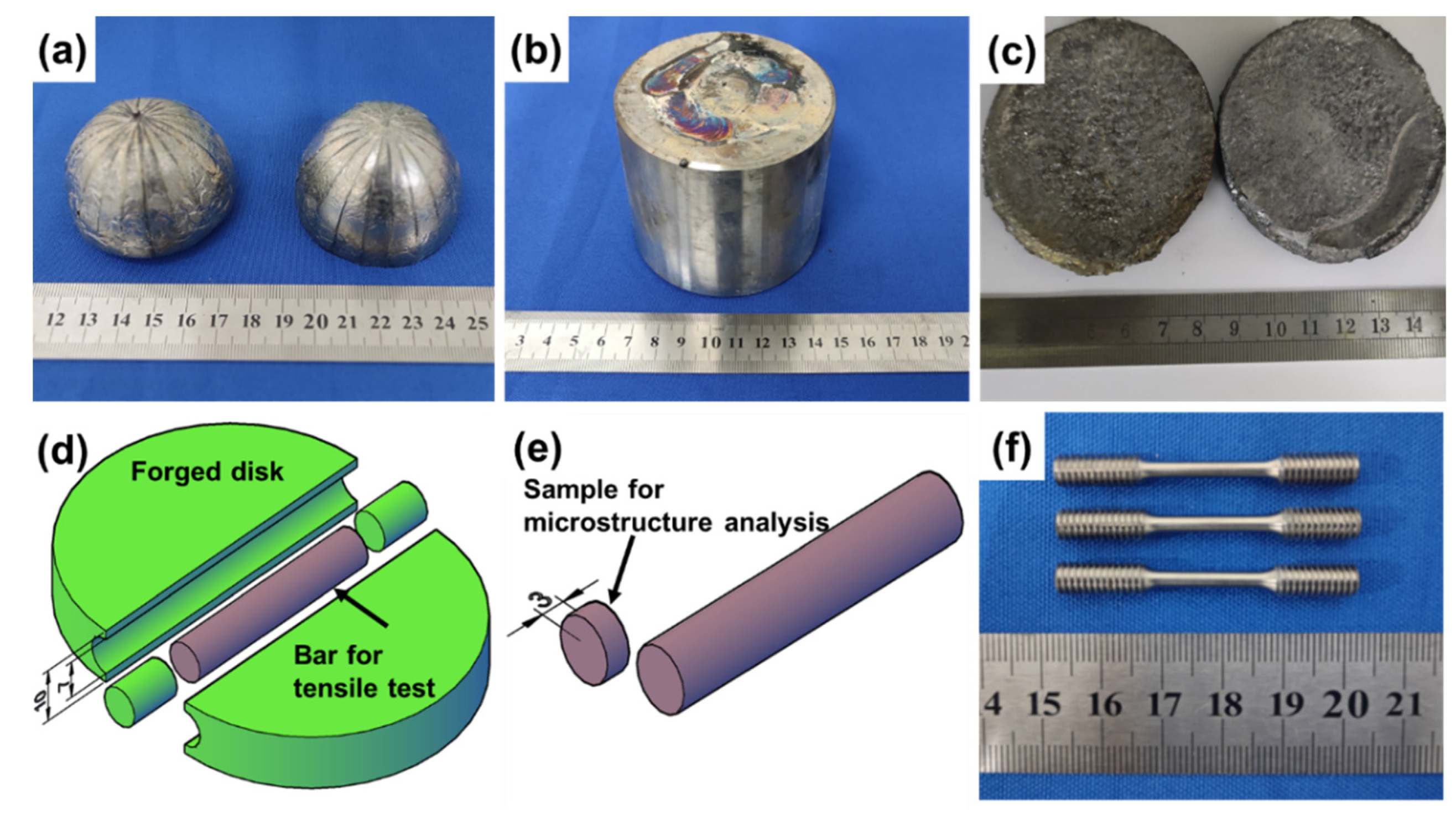

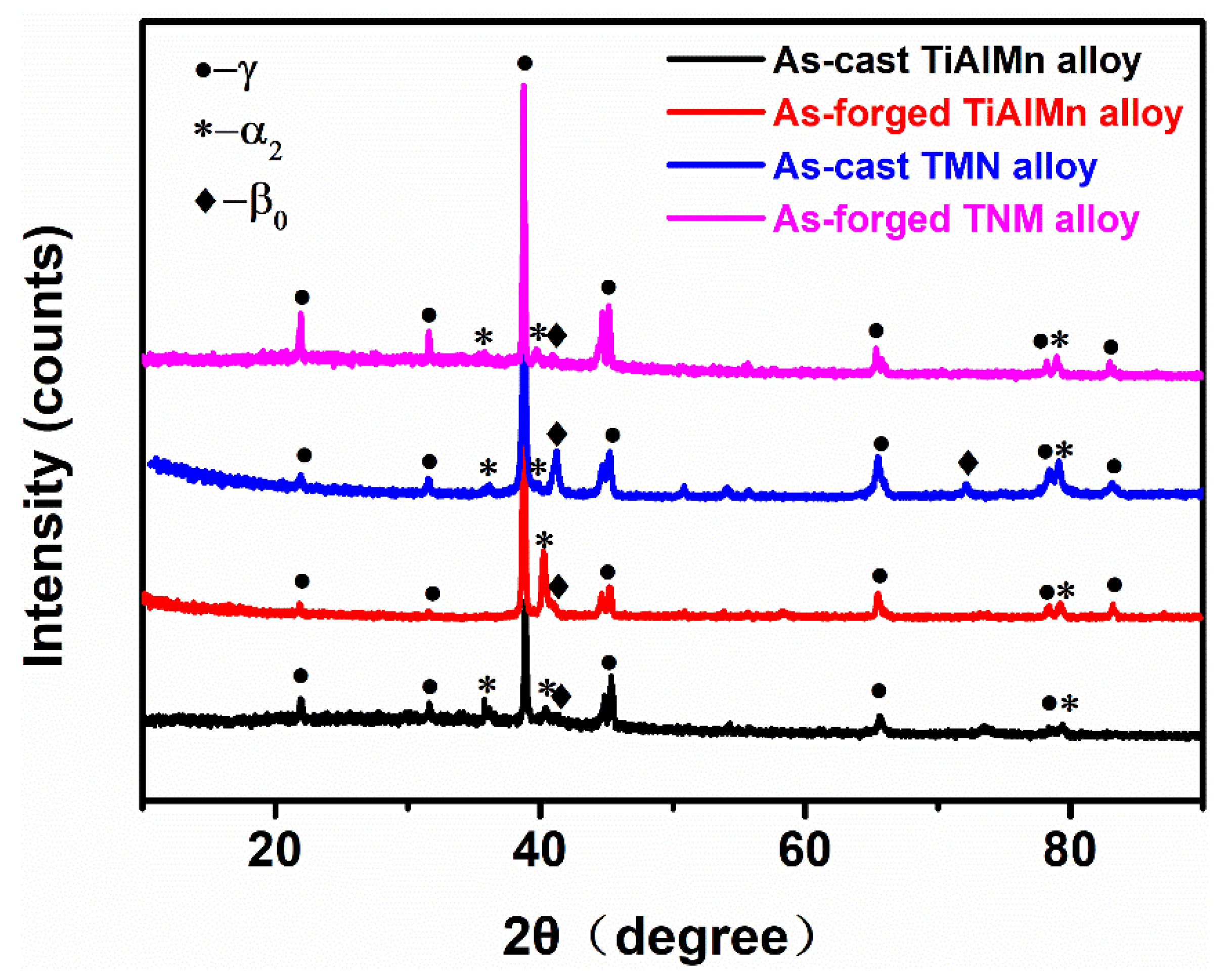
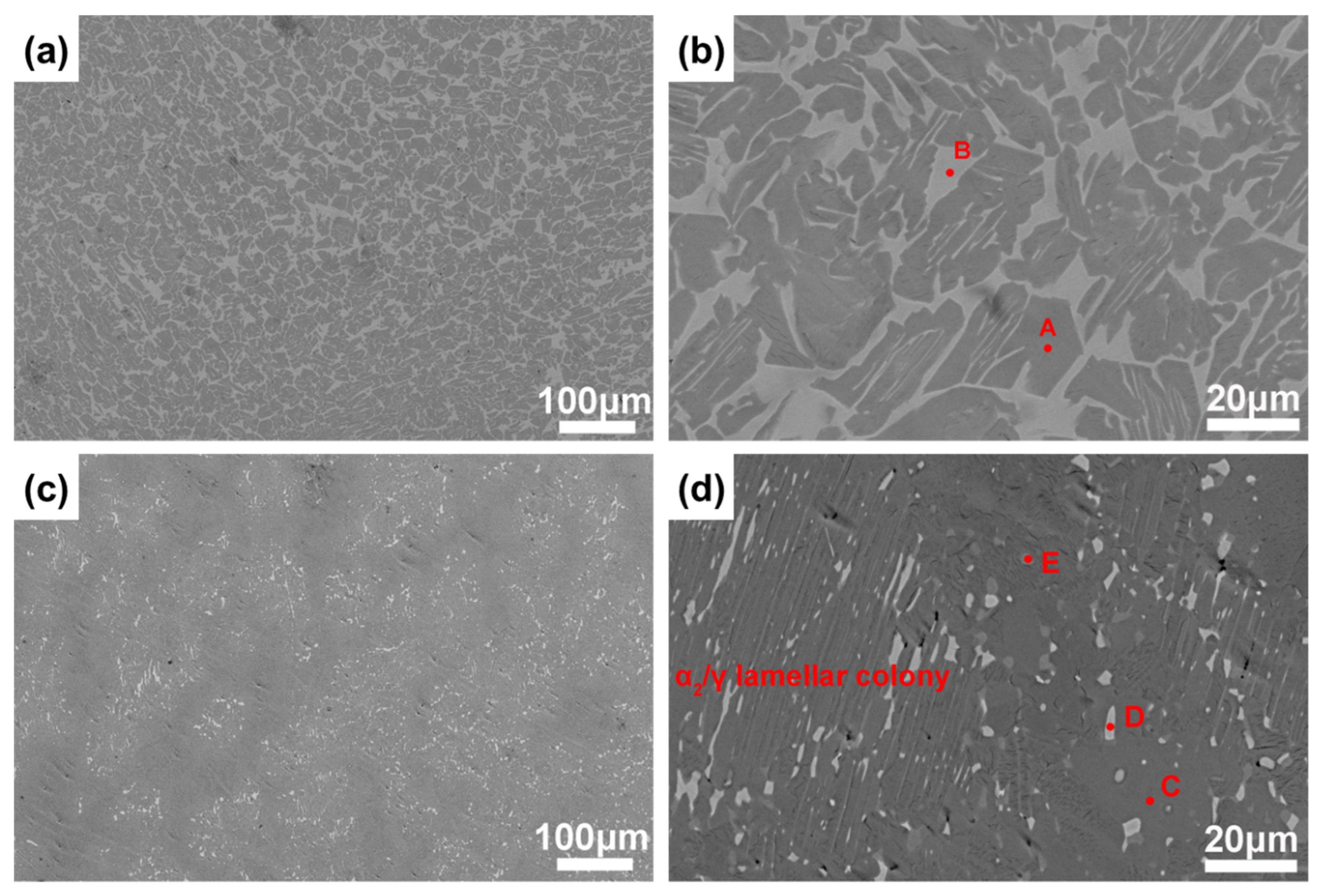
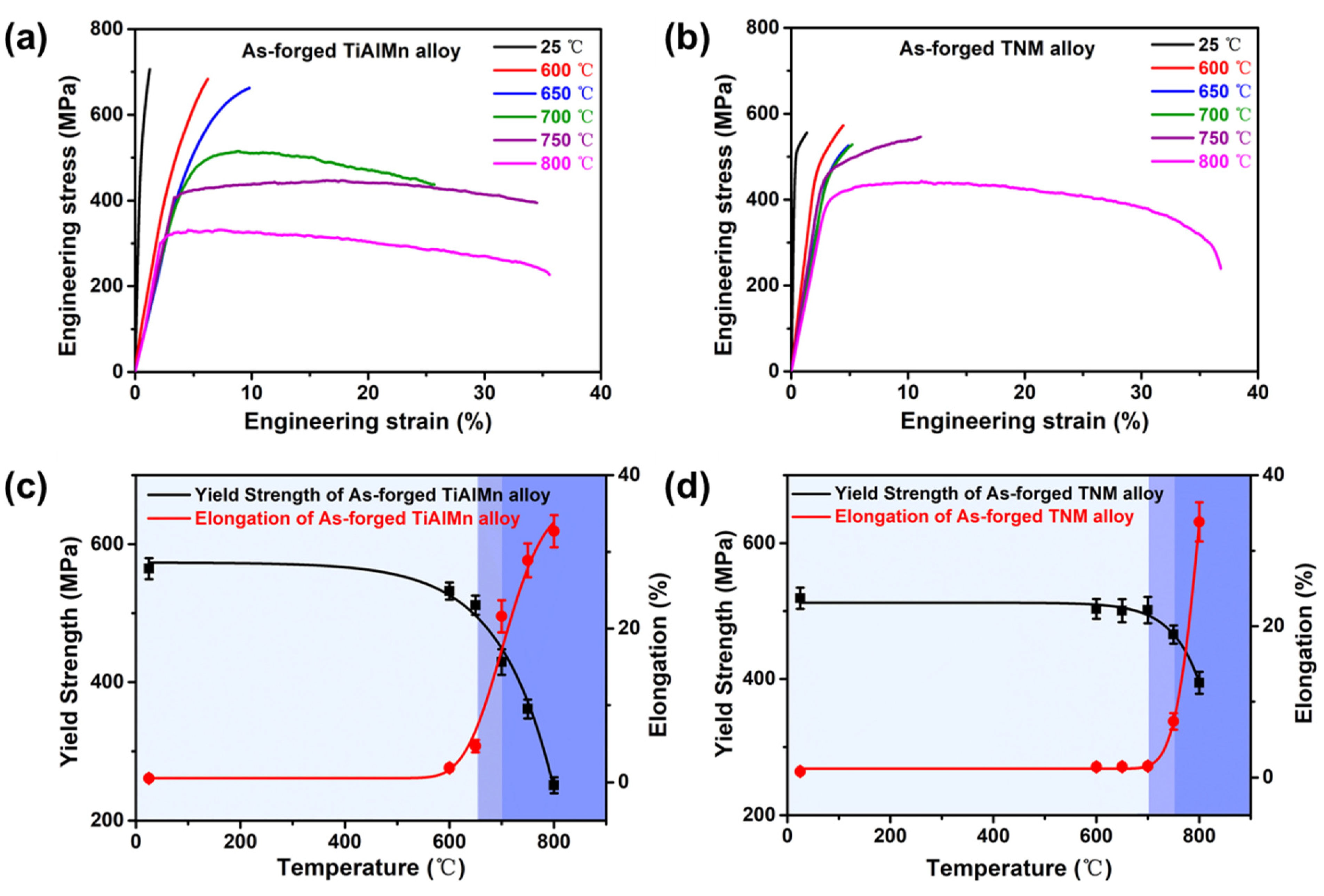
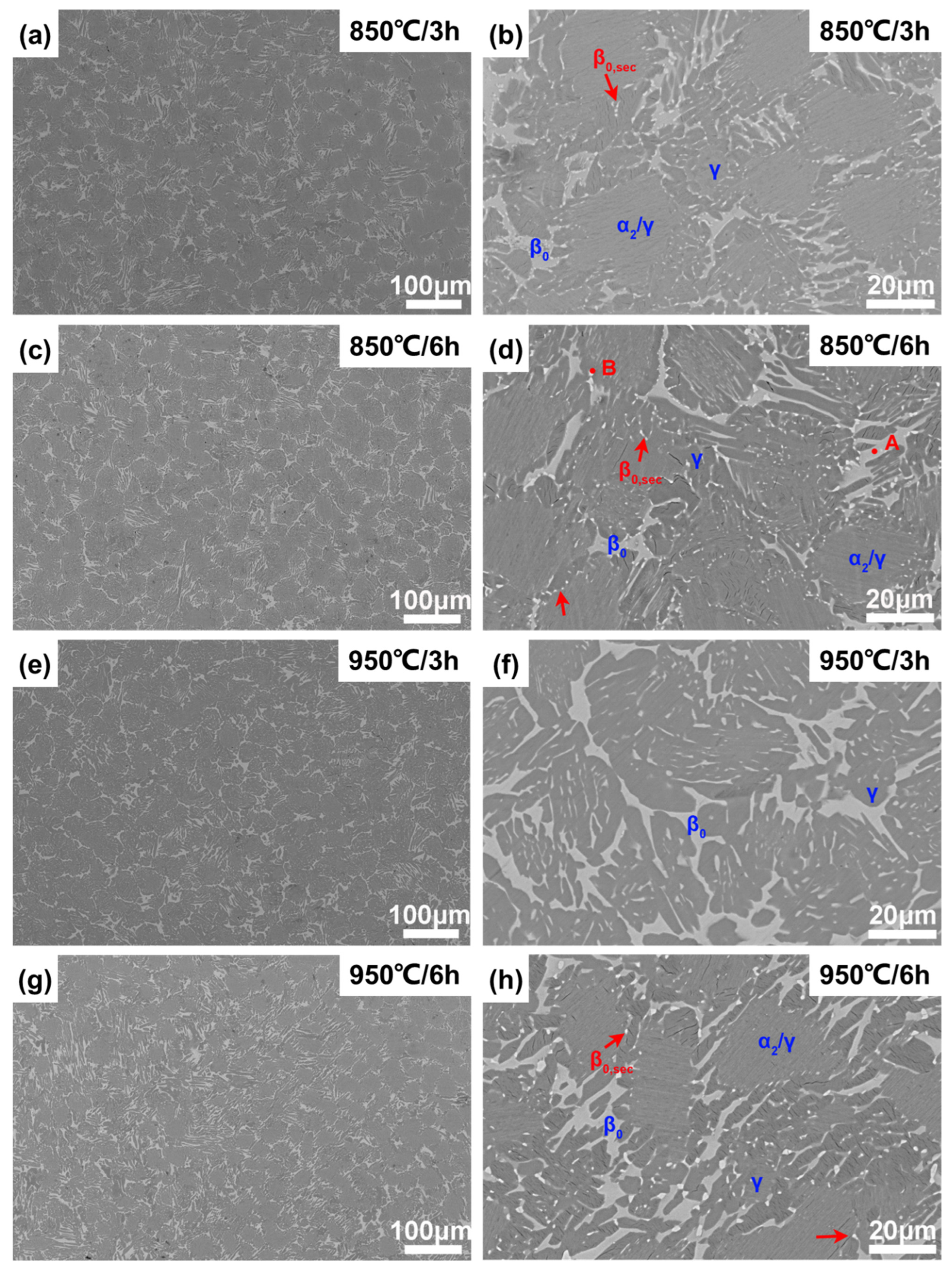

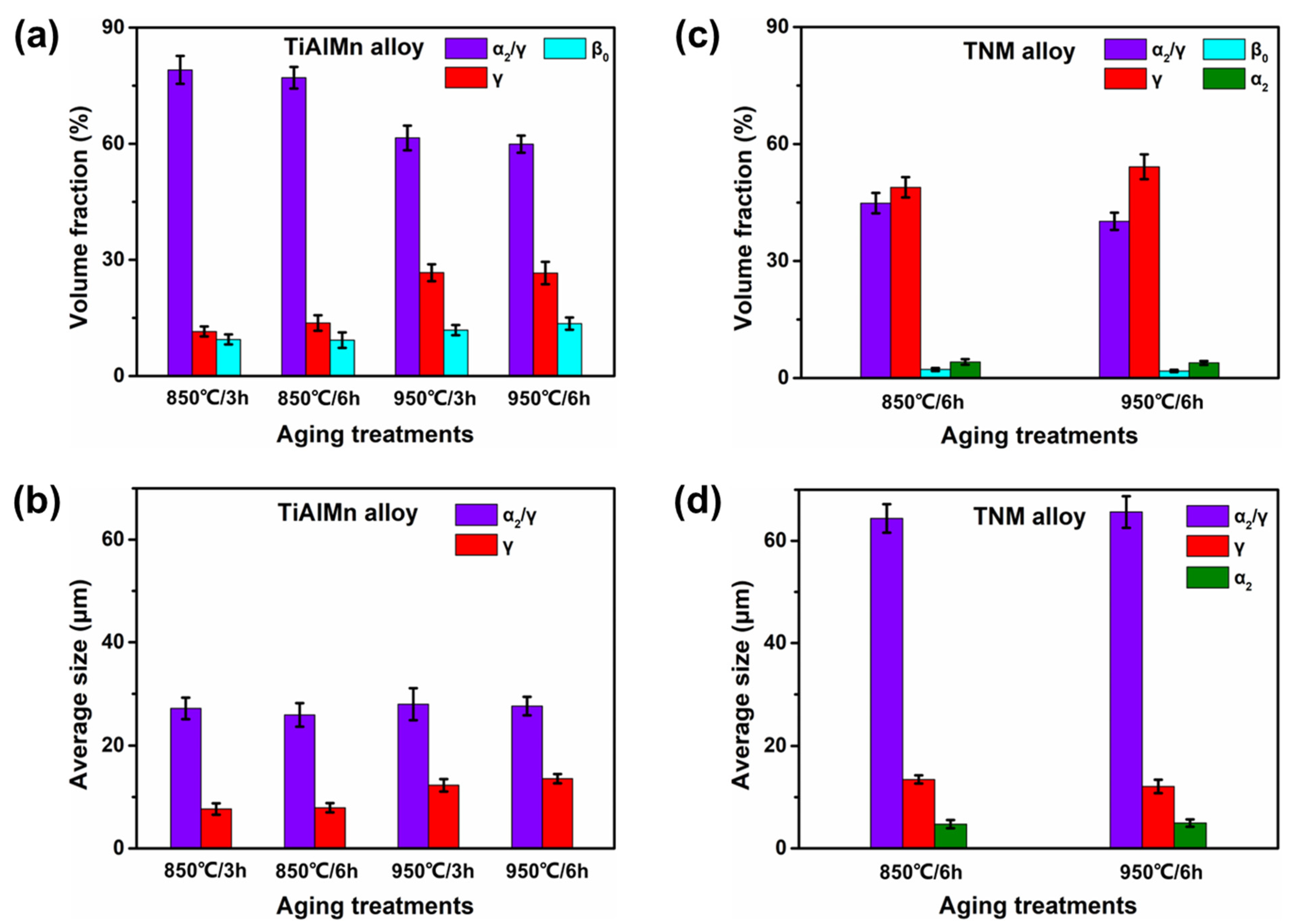
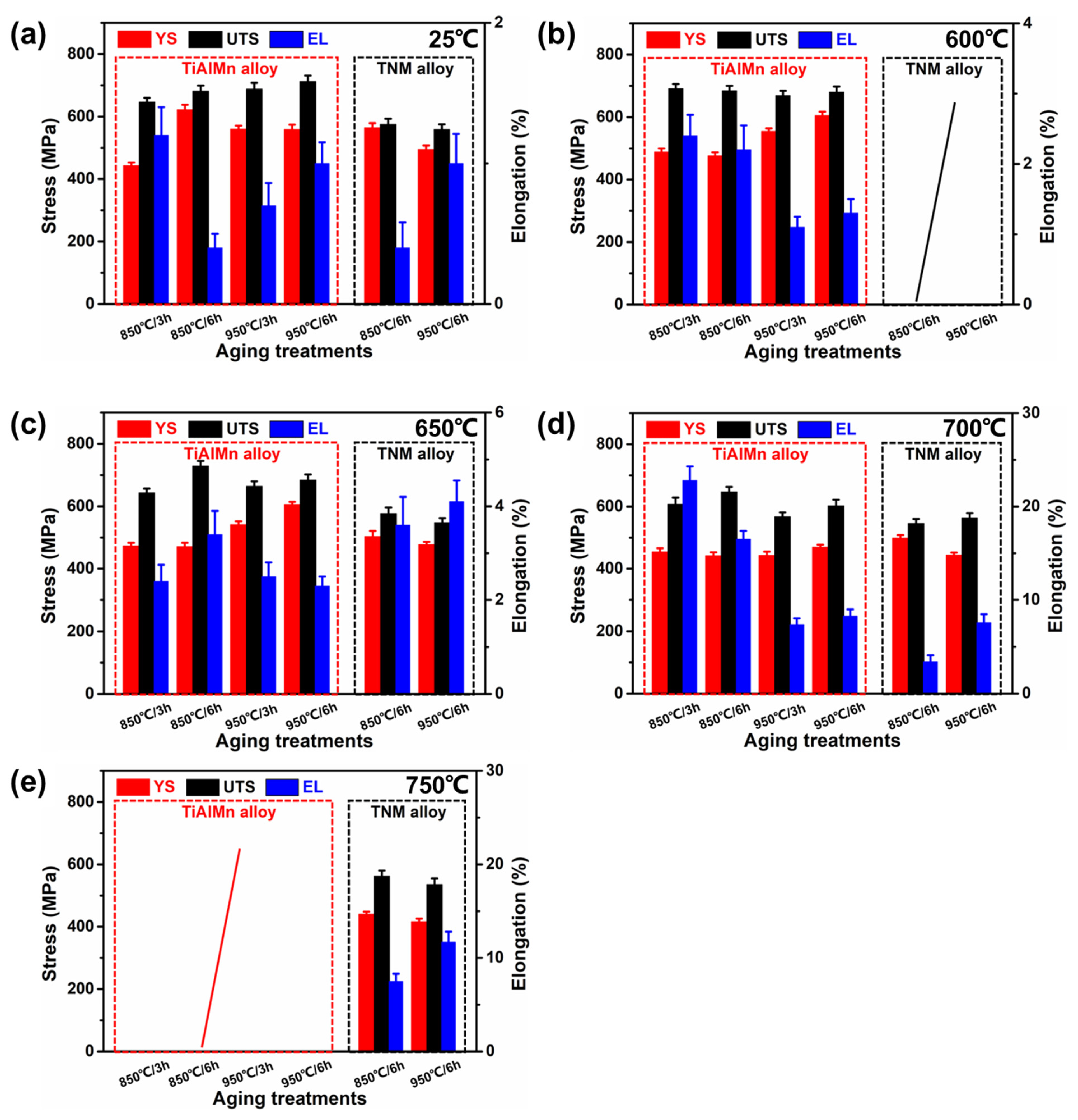

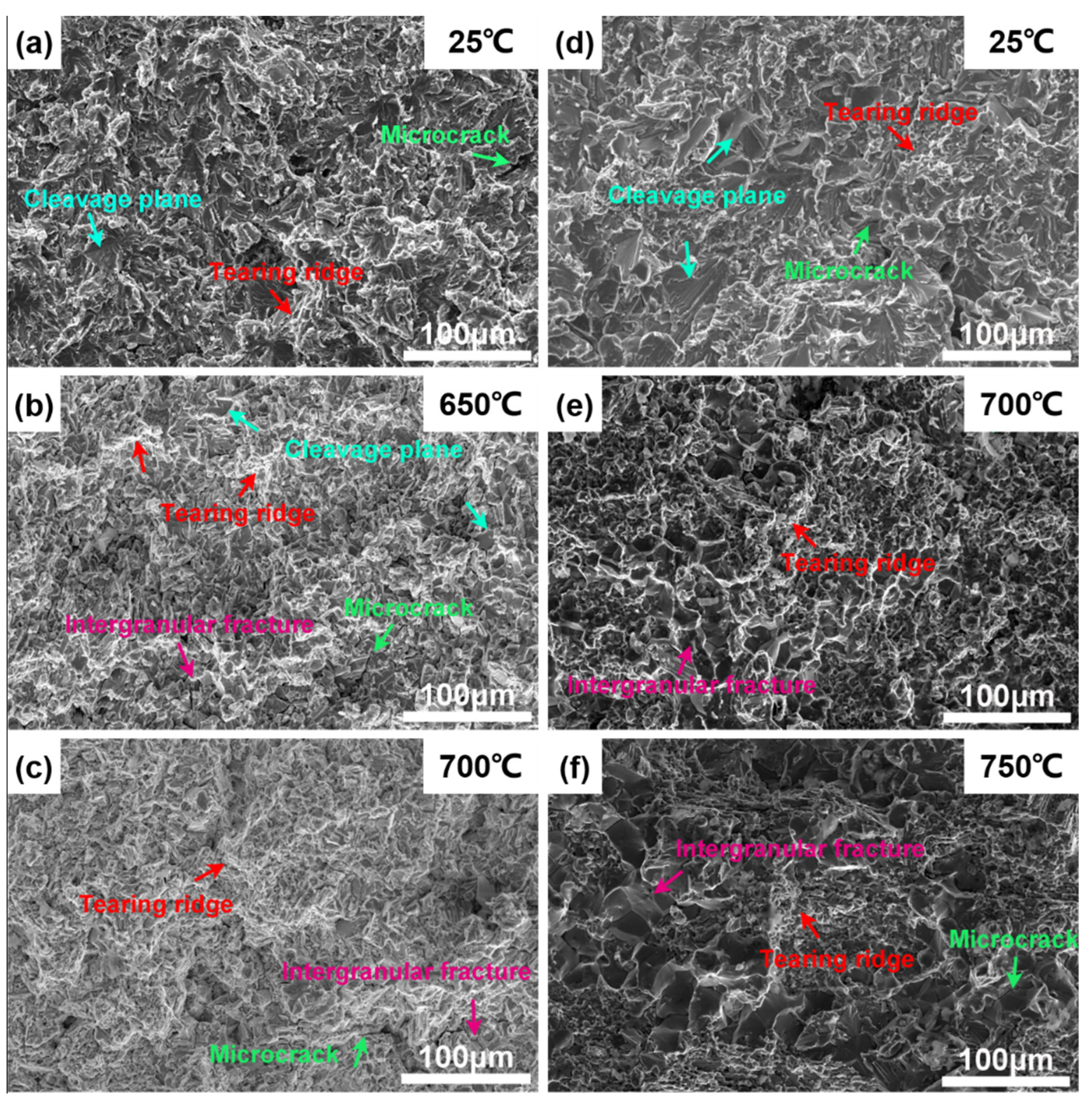
| Name | Alloy | Solution Treatment | Cooling | Aging Treatment | Cooling |
|---|---|---|---|---|---|
| HT1 | TiAlMn | 1280 °C/30 min | AC | 850 °C/3 h | FC |
| HT2 | 850 °C/6 h | ||||
| HT3 | 950 °C/3 h | ||||
| HT4 | 950 °C/6 h | ||||
| HT5 | TNM | 1230 °C/1 h | AC | 850 °C/6 h | FC |
| HT6 | 950 °C/6 h |
| Position | Elements (Atomic Fraction, %) | Possible Phase | ||||
|---|---|---|---|---|---|---|
| Ti | Al | Nb | Mo | Mn | ||
| A | 52.10 | 43.85 | - | - | 4.05 | γ |
| B | 56.48 | 33.86 | - | - | 9.66 | β0 |
| C | 48.68 | 47.20 | 3.37 | 0.75 | - | γ |
| D | 52.27 | 36.72 | 5.25 | 2.76 | - | β0 |
| E | 55.20 | 39.09 | 4.15 | 1.56 | - | α2 |
| Position | Element (Atomic Fraction, %) | ||
|---|---|---|---|
| Ti | Al | Mn | |
| A | 55.08 | 32.28 | 12.64 |
| B | 39.47 | 31.77 | 28.76 |
| Alloys | Heat Treatments | 25 °C | 600 °C | 650 °C | 700 °C | 750 °C | ||||||||||
|---|---|---|---|---|---|---|---|---|---|---|---|---|---|---|---|---|
| YS MPa | UTS MPa | EL % | YS MPa | UTS MPa | EL % | YS MPa | UTS MPa | EL % | YS MPa | UTS MPa | EL % | YS MPa | UTS MPa | EL % | ||
| TiAlMn | HT1 | 443 | 646 | 1.2 | 488 | 691 | 2.4 | 473 | 643 | 2.4 | 454 | 607 | 22.8 | - | - | - |
| HT2 | 622 | 681 | 0.4 | 476 | 684 | 2.2 | 471 | 729 | 3.4 | 442 | 647 | 16.5 | - | - | - | |
| HT3 | 560 | 688 | 0.7 | 554 | 669 | 1.1 | 541 | 664 | 2.5 | 443 | 567 | 7.4 | - | - | - | |
| HT4 | 559 | 712 | 1.0 | 605 | 680 | 1.3 | 605 | 684 | 2.3 | 469 | 602 | 8.3 | - | - | - | |
| TNM | HT5 | 564 | 575 | 0.4 | - | - | - | 503 | 576 | 3.6 | 498 | 545 | 3.4 | 440 | 562 | 7.5 |
| HT6 | 494 | 559 | 1.0 | - | - | - | 477 | 547 | 4.1 | 444 | 563 | 7.6 | 416 | 535 | 11.7 | |
Publisher’s Note: MDPI stays neutral with regard to jurisdictional claims in published maps and institutional affiliations. |
© 2022 by the authors. Licensee MDPI, Basel, Switzerland. This article is an open access article distributed under the terms and conditions of the Creative Commons Attribution (CC BY) license (https://creativecommons.org/licenses/by/4.0/).
Share and Cite
Su, X.; Li, P.; Qu, H.; Feng, C.; Hou, R.; Song, W.; Tian, B.; Xu, H. A Study on the Brittle-to-Ductile Transition Temperature of Forged β-Solidifying TiAlMn and TNM Alloys. Crystals 2022, 12, 1498. https://doi.org/10.3390/cryst12101498
Su X, Li P, Qu H, Feng C, Hou R, Song W, Tian B, Xu H. A Study on the Brittle-to-Ductile Transition Temperature of Forged β-Solidifying TiAlMn and TNM Alloys. Crystals. 2022; 12(10):1498. https://doi.org/10.3390/cryst12101498
Chicago/Turabian StyleSu, Xiang, Pei Li, Hongjie Qu, Chenming Feng, Rui Hou, Weidong Song, Bo Tian, and Hao Xu. 2022. "A Study on the Brittle-to-Ductile Transition Temperature of Forged β-Solidifying TiAlMn and TNM Alloys" Crystals 12, no. 10: 1498. https://doi.org/10.3390/cryst12101498
APA StyleSu, X., Li, P., Qu, H., Feng, C., Hou, R., Song, W., Tian, B., & Xu, H. (2022). A Study on the Brittle-to-Ductile Transition Temperature of Forged β-Solidifying TiAlMn and TNM Alloys. Crystals, 12(10), 1498. https://doi.org/10.3390/cryst12101498






